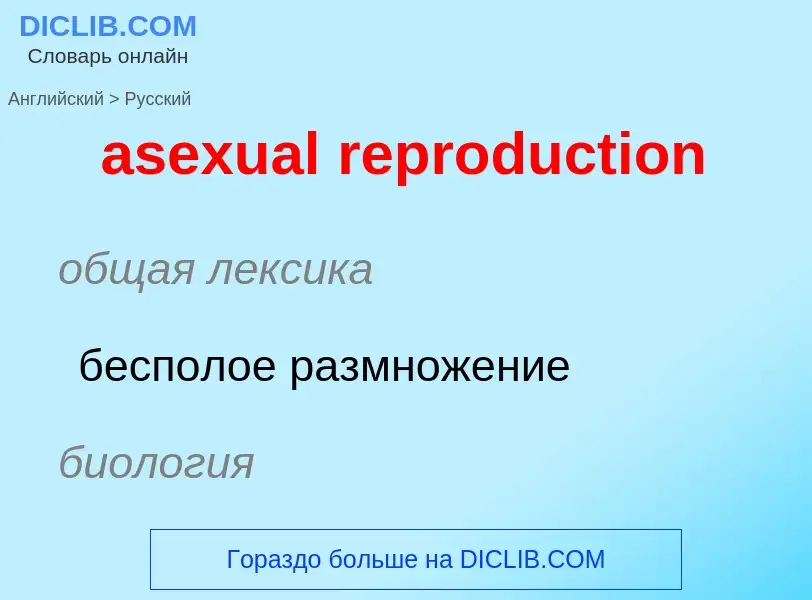Translation and analysis of words by ChatGPT artificial intelligence
On this page you can get a detailed analysis of a word or phrase, produced by the best artificial intelligence technology to date:
- how the word is used
- frequency of use
- it is used more often in oral or written speech
- word translation options
- usage examples (several phrases with translation)
- etymology
asexual reproduction - translation to russian
общая лексика
бесполое размножение
биология
агамогония
общая лексика
агамогония
[mə'nɔgəni]
общая лексика
моногония
бесполое размножение
синоним
Definition
Wikipedia

Asexual reproduction is a type of reproduction that does not involve the fusion of gametes or change in the number of chromosomes. The offspring that arise by asexual reproduction from either unicellular or multicellular organisms inherit the full set of genes of their single parent and thus the newly created individual is genetically and physically similar to the parent or an exact clone of the parent. Asexual reproduction is the primary form of reproduction for single-celled organisms such as archaea and bacteria. Many eukaryotic organisms including plants, animals, and fungi can also reproduce asexually. In vertebrates, the most common form of asexual reproduction is parthenogenesis, which is typically used as an alternative to sexual reproduction in times when reproductive opportunities are limited. Komodo dragons and some monitor lizards can also reproduce asexually.
While all prokaryotes reproduce without the formation and fusion of gametes, mechanisms for lateral gene transfer such as conjugation, transformation and transduction can be likened to sexual reproduction in the sense of genetic recombination in meiosis.


![[[Aphid]] giving birth to live young from an unfertilized egg [[Aphid]] giving birth to live young from an unfertilized egg](https://commons.wikimedia.org/wiki/Special:FilePath/Aphid-giving-birth.jpg?width=200)
![Bryophyllum daigremontianum (Kalanchoe daigremontiana)]]'' Bryophyllum daigremontianum (Kalanchoe daigremontiana)]]''](https://commons.wikimedia.org/wiki/Special:FilePath/Bryophyllum daigremontianum nahaufnahme1.jpg?width=200)
![The yeast ''[[Saccharomyces cerevisiae]]'' reproducing by [[budding]] The yeast ''[[Saccharomyces cerevisiae]]'' reproducing by [[budding]]](https://commons.wikimedia.org/wiki/Special:FilePath/S cerevisiae under DIC microscopy.jpg?width=200)
![[[Aphid]] populations are often entirely female during the summer, with sexual reproduction only to produce eggs for overwintering. [[Aphid]] populations are often entirely female during the summer, with sexual reproduction only to produce eggs for overwintering.](https://commons.wikimedia.org/wiki/Special:FilePath/Soybeanaphidlifecycle.gif?width=200)
![''[[Linckia guildingi]]'' "comet", a [[starfish]] regrowing from a single arm ''[[Linckia guildingi]]'' "comet", a [[starfish]] regrowing from a single arm](https://commons.wikimedia.org/wiki/Special:FilePath/Tu - Linckia guildingi cropped.jpg?width=200)
